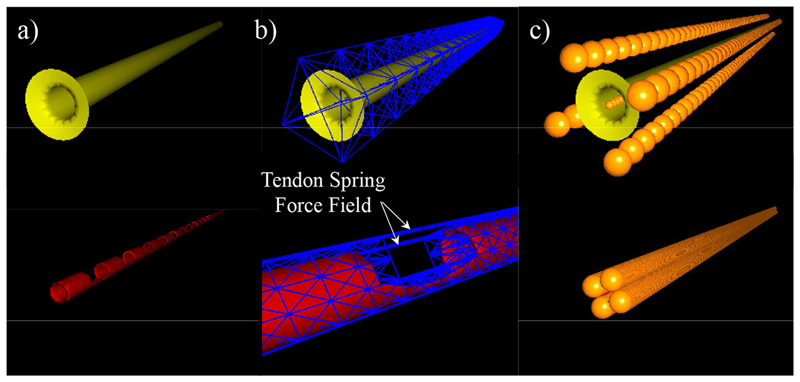一种基于物理的可操纵Eversion生长机器人模型
IF 4.6
2区 计算机科学
Q2 ROBOTICS
引用次数: 2
摘要
通过外翻/根尖延伸生长的软机器人可以有效地在人体内的导管和血管等脆弱环境中导航。这封信介绍了一个微型可转向外翻生长机器人的物理模型。我们展示了机器人的生长、转向、强化和交互能力。探讨了两个机器人内部组件之间的相互作用,即用于机器人尖端定向的可操纵导管和用于机器人伸长/缩回的生长鞘。研究了生长机器人在不同内部压力和外部尖端力作用下的行为。模拟是在SOFA框架内进行的。对物理机器人设置的大量实验证明了与模拟的一致性。比较表明,曲率值的模拟结果和实验结果之间的平均绝对误差为10-20%,包括仅导管实验、仅鞘管实验和全系统实验。据我们所知,这是第一项探索肌腱驱动可控外翻生长机器人基于物理建模的工作。虽然我们的工作是通过乳腺导管检查进行早期乳腺癌症检测,并使用我们的MAMMOBOT机器人原型,但我们的方法是通用的,与类似的生长机器人相关。本文章由计算机程序翻译,如有差异,请以英文原文为准。



Towards a Physics-Based Model for Steerable Eversion Growing Robots
Soft robots that grow through eversion/apical extension can effectively navigate fragile environments such as ducts and vessels inside the human body. This letter presents the physics-based model of a miniature steerable eversion growing robot. We demonstrate the robot's growing, steering, stiffening and interaction capabilities. The interaction between two robot-internal components is explored, i.e., a steerable catheter for robot tip orientation, and a growing sheath for robot elongation/retraction. The behavior of the growing robot under different inner pressures and external tip forces is investigated. Simulations are carried out within the SOFA framework. Extensive experimentation with a physical robot setup demonstrates agreement with the simulations. The comparison demonstrates a mean absolute error of 10–20% between simulation and experimental results for curvature values, including catheter-only experiments, sheath-only experiments and full system experiments. To our knowledge, this is the first work to explore physics-based modelling of a tendon-driven steerable eversion growing robot. While our work is motivated by early breast cancer detection through mammary duct inspection and uses our MAMMOBOT robot prototype, our approach is general and relevant to similar growing robots.
求助全文
通过发布文献求助,成功后即可免费获取论文全文。
去求助
来源期刊

IEEE Robotics and Automation Letters
Computer Science-Computer Science Applications
CiteScore
9.60
自引率
15.40%
发文量
1428
期刊介绍:
The scope of this journal is to publish peer-reviewed articles that provide a timely and concise account of innovative research ideas and application results, reporting significant theoretical findings and application case studies in areas of robotics and automation.
 求助内容:
求助内容: 应助结果提醒方式:
应助结果提醒方式:


